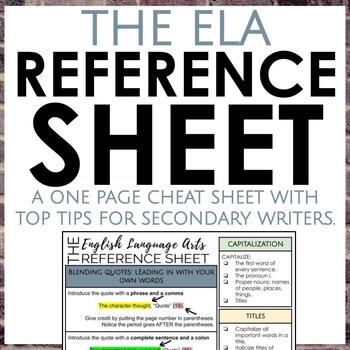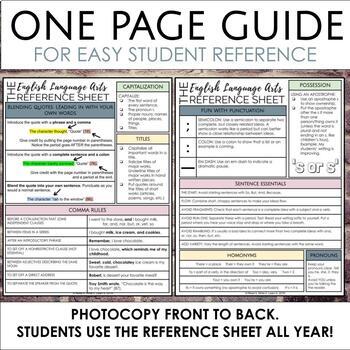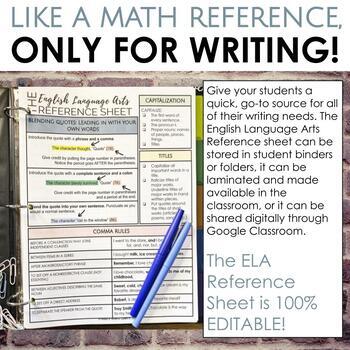The English Language Arts Reference Sheet for Secondary ELA Writing
Read it Write it Learn it
11k Followers
Grade Levels
6th - 10th
Subjects
Resource Type
Standards
CCSSCCRA.W.4
CCSSCCRA.W.5
CCSSCCRA.W.6
CCSSCCRA.W.10
Formats Included
- PDF
Pages
3 pages
Read it Write it Learn it
11k Followers
What educators are saying
This reference sheet is great for 7th graders! I handed it out at the beginning of the year as we organized our ELA binders. This reference sheet goes in FIRST before their dividers so its easy and quick to access!
I made color copies for all of my students, (which is a big deal), and gave this at the beginning of the year. We have a section in binder called VIPs -- very important papers. This is kept there for easy reference throughout the year.
Description
Why should math teachers have all the fun? Give your Secondary ELA students an easy to read, easy to access, one page (front and back) reference sheet for writing that they can use all year long.
Includes tips for blending quotes, capitalization, title punctuation, comma use, possession, fun with punctuation, sentence essentials, homonyms, and pronoun use. Simply photocopy one sheet per student and store in binders or folders. Laminate copies to use as an in-class reference all year! Share in Google Classroom.
Your ELA Reference Sheet is completely editable.
Next time you have 30 hands in the air asking for writing help, remind your students to check their reference sheet first!
Total Pages
3 pages
Answer Key
N/A
Teaching Duration
Lifelong tool
Report this resource to TPT
Reported resources will be reviewed by our team. Report this resource to let us know if this resource violates TPT’s content guidelines.
Standards
to see state-specific standards (only available in the US).
CCSSCCRA.W.4
Produce clear and coherent writing in which the development, organization, and style are appropriate to task, purpose, and audience.
CCSSCCRA.W.5
Develop and strengthen writing as needed by planning, revising, editing, rewriting, or trying a new approach.
CCSSCCRA.W.6
Use technology, including the Internet, to produce and publish writing and to interact and collaborate with others.
CCSSCCRA.W.10
Write routinely over extended time frames (time for research, reflection, and revision) and shorter time frames (a single sitting or a day or two) for a range of tasks, purposes, and audiences.




